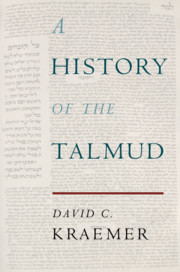Book contents
- A History of the Talmud
- A History of the Talmud
- Copyright page
- Contents
- Preface
- Glossary
- Timeline
- Chapter 1 Introduction
- Chapter 2 Before the Rabbis
- Chapter 3 The Emergence of the Mishnah
- Chapter 4 What Is the Mishnah?
- Chapter 5 The Reception of the Mishnah
- Chapter 6 The First Talmud
- Chapter 7 Jews in Babylonia and the Emergence of the Babylonian Talmud (the Bavli)
- Chapter 8 What Is the Bavli?
- Chapter 9 The Reception of the Bavli
- Chapter 10 The Talmud in Early Modernity
- Chapter 11 The Talmud in Modernity and Beyond
- References
- Index
Chapter 11 - The Talmud in Modernity and Beyond
Published online by Cambridge University Press: 18 July 2019
- A History of the Talmud
- A History of the Talmud
- Copyright page
- Contents
- Preface
- Glossary
- Timeline
- Chapter 1 Introduction
- Chapter 2 Before the Rabbis
- Chapter 3 The Emergence of the Mishnah
- Chapter 4 What Is the Mishnah?
- Chapter 5 The Reception of the Mishnah
- Chapter 6 The First Talmud
- Chapter 7 Jews in Babylonia and the Emergence of the Babylonian Talmud (the Bavli)
- Chapter 8 What Is the Bavli?
- Chapter 9 The Reception of the Bavli
- Chapter 10 The Talmud in Early Modernity
- Chapter 11 The Talmud in Modernity and Beyond
- References
- Index
Summary
The nineteenth century brought significant developments in the place of the Talmud in Jewish society. The creation of modern yeshivahs enhanced the prestige of the rabbinic scholar and solidified rabbinic authority in traditional circles. Enlightenment and emancipation led to the birth of Reform, which rejected the hegemony of yeshivahs and their Talmud. The question of the place of the Talmud in the education of a modern Jew emerged with urgency, and modern Jewish movements developed different opinions regarding its ongoing relevance. Crucially, the Talmud even escaped Jewish settings and methods, finding a place in universities and modern seminaries. Turning to recent times, we consider the consequences of the fact that there are today more printed Talmuds, in more languages, than ever before, meaning that more people (male and female) study Talmud in more ways than ever in history. We explore this range of new Talmudic expressions, including women’s yeshivot, secular yeshivot, feminist Talmud study groups, digital Talmud, and more. In the end, we ask what the unifying thread of the power of the Talmud may be, despite its many meanings and functions through history.
Keywords
- Type
- Chapter
- Information
- A History of the Talmud , pp. 237 - 272Publisher: Cambridge University PressPrint publication year: 2019



